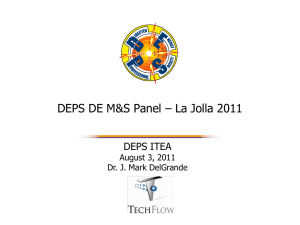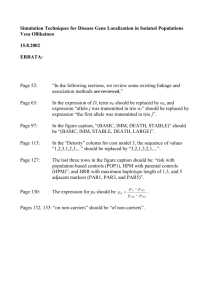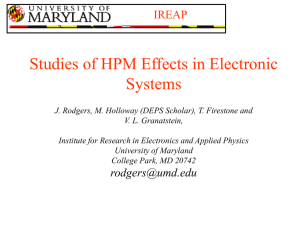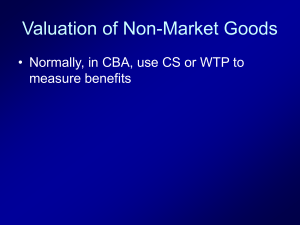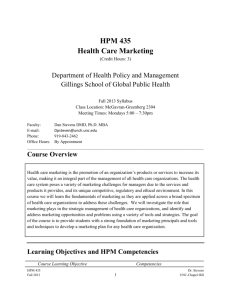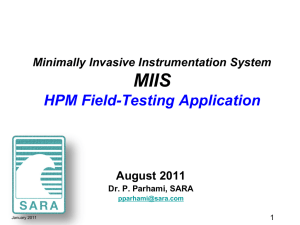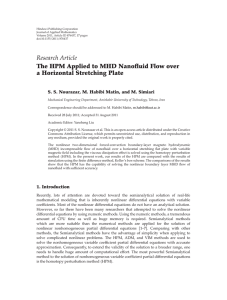Dr. Ekin Birol
advertisement
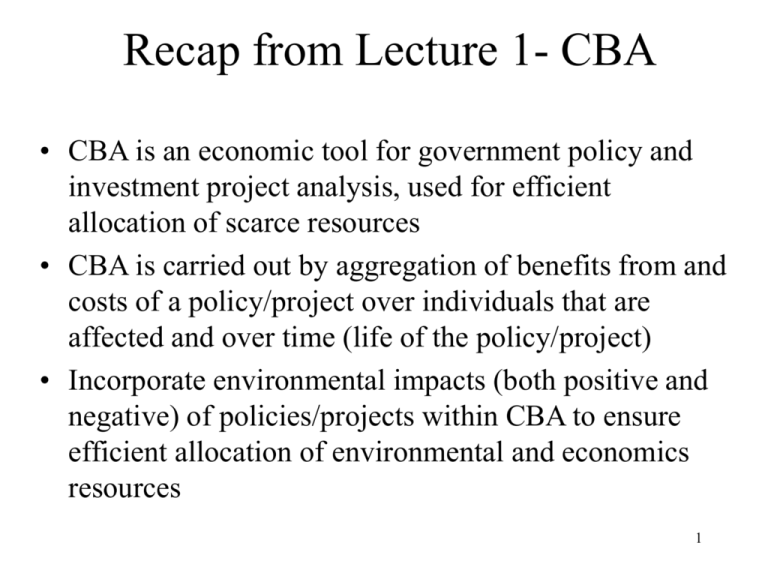
Recap from Lecture 1- CBA • CBA is an economic tool for government policy and investment project analysis, used for efficient allocation of scarce resources • CBA is carried out by aggregation of benefits from and costs of a policy/project over individuals that are affected and over time (life of the policy/project) • Incorporate environmental impacts (both positive and negative) of policies/projects within CBA to ensure efficient allocation of environmental and economics resources 1 Recap from Lecture 1-TEV • Environmental goods are public goods (non-rival and non-excludable) • They are not traded in the markets and hence they do not have readily available prices that can be used in CBA • Value of environmental goods have a broader definition: Total Economic Value (TEV) 2 Recap from Lecture 1-TEV Total Economic Value: • Use Values: Related to values derived from using the environmental good – Direct use value: Value that come from the consumptive use of the environmental good – Indirect use value: Value of functions of the environmental good – Option value: values of conserving the option of making use of the environmental good in the future even though no current use is made of it. • Non-use values: Unrelated to the value of current or planned use of the environmental good – Bequest value: Value of knowing that future generations will benefit from the environmental good – Altruistic value: Value of knowing that other individuals in this generation benefit from the environmental good – Existence value: Value of knowing that the environmental good exists even if no one in this generation or in the future generations will ever use it. 3 TEV of a Wetland USE VALUES Direct Use Value Indirect Use Value fish nutrient retention agriculture flood control fuelwood storm protection recreation groundwater transport recharge wildlife harvesting external energy ecosystem support micro-climatic stabilisation shoreline stabilisation, etc. NON-USE VALUES Option Value potential future uses (as per direct and indirect uses) bequest value altruistic value existence value related to biodiversity and cultural heritage future value of information Barbier et al. 1997 4 Recap from Lecture 1 • TEV can be estimated using environmental valuation methods. These are – Revealed Preference Methods • Hedonic Pricing Method • Travel Cost Method – Stated Preference Methods • Contingent Valuation Method • Choice Experiment Method 5 Reading List • Hanley N., Shogren, J. and White, B. (2001) An Introduction to Environmental Economics, Oxford University Press, Oxford. – Chapters 2, 3 and 4 • Pearce, D.W and Turner, K. (1990) Economics of Natural Resources and the Environment, Harvester Wheatsheaf, London – Chapters 9 and 10 • Kolstad, C.D.(2000) Environmental Economics, Oxford University Press, Oxford – Chapters 4 (pp.68-74), 15, 16, 17 (pp.344-350) and 18 • Perman, R., Ma, Y., McGilvray, J., and Common, M. (2003) Natural Resource and Environmental Economics, Longman, Harlow, 3rd Edition – Chapters 11 and 12 6 Valuing Environmental Goods • Deciding to use the environmental goods one way or other entails a cost. • Is it worth sacrificing environmental goods to obtain market goods? • Economists measure TEV in terms of willingness to pay (WTP) or willingness to accept (WTA) • Compare maximum WTP for the environmental good with the market value of the goods for which the destruction of the environmental goods is required. • Or compare minimum WTA compensation for the loss of environmental resources with the market value of the goods for which the destruction of the 7 environmental goods is required. Valuing Environmental Goods • WTA and WTP differ in terms of: – Income: WTP is limited by one’s income and WTA is unbounded. One is richer when one owns the item and is being compensated for it, than one must pay to obtain it. – Property rights: If one has the property right to an environmental good, then the appropriate concept is WTA. If one does not have the property rights then use WTP. Many environmental gods are public goods, sometimes current allocation is taken as the property rights, that is improvements in environmental quality is measured as WTP and reductions in environmental quality is measures as WTA. • The concepts of WTP and WTA for an environmental good can be explained using IC. 8 Hedonic Pricing Method (HPM) • HPM is used to estimate the economic values of an environmental good that directly affect prices of marketed goods. • It is most commonly applied to variations in property prices to estimate the value of local environmental goods. • It can be used to estimate economic benefits or costs associated with: – environmental quality, including air pollution, water pollution, noise, soil quality, water quality, erosion, drainage, proximity to waste sites – environmental amenities, such as aesthetic views (sea, lake, forest) or proximity to recreational sites (e.g. coast, open 9 space) HPM – Main assumption • HPM is based on Lancaster’s characteristics theory of value (Lancaster, 1966). That is people value the characteristics of a good, or the services it provides, rather than the good itself. • Thus, property prices will reflect the value of a set of characteristics, including environmental characteristics, that people consider important when purchasing a property. 10 HPM – Main assumption • The price of a property is related to its characteristics, the characteristics of the neighbourhood and community, and environmental characteristics. • Thus, if non-environmental factors are controlled for, then any remaining differences in price can be attributed to differences in environmental quality. • For example, if all characteristics of properties and neighbourhoods throughout an area were the same, except for the level of air pollution, then houses with better air quality would cost more. This higher price reflects the value of cleaner air to people who purchase houses in the area. 11 HPM – Data requirement • To apply the hedonic pricing method, the following information must be collected: – A measure or index of the environmental amenity of interest (e.g. for air pollution measurements of SO2, SO3, H2S, H2SO4 etc. or for distance to hazardous waste sites distance in km) – Cross-section and/or time-series data on property prices and property and household characteristics for a welldefined market area that includes homes with different levels of environmental quality, or different distances to an environmental amenity. 12 HPM - Analysis • The data are analysed using regression analysis. • Regression analysis: A statistical process for fitting a line through a set of data points. It gives the intercept and slope(s) of the “best fitting” line. Thus it tells how much one variable (the dependent variable) will change when other variables (the independent, or explanatory, variables) change. • In the first stage of HPM, regression analysis is used to estimates the hedonic price function, which relates the price of the property to its characteristics and the environmental characteristic(s) of interest. Thus, the effects of different characteristics on price can be estimated. 13 HPM - Analysis • The regression results indicate how much property values will change for a small change in each characteristic, holding all other characteristics constant. • That is differentiating the hedonic price function with respect to any one of the characteristics yields the implicit price function (implicit because it is revealed to us indirectly through the amounts people are prepared to pay for the whole property of which the particular characteristic is only a part). 14 HPM- Analysis • In the second stage of HPM, the demand function (marginal WTP) is identified. To identify the demand function information. There are two ways information on individuals’ demand (marginal WTP) for a good at different prices – either observe individuals’ demand for a good in one market when the price of the good changes over time – or observe individuals’ demand for a good in different markets where the good is traded at different prices. • In general, the only way we can identify the marginal WTP curve is to have observations on households with the same characteristics facing different implicit prices. 15 HPM- Advantages • HPM is relatively straightforward and uncontroversial to apply, because it is based on actual market prices and fairly easily measured data. • Property markets are relatively efficient in responding to information, so can be good indications of value. • Property records are typically very reliable. • Data on property sales and characteristics are generally readily available through many sources. • If data are readily available, it can be relatively inexpensive to apply. 16 HPM- Limitations • The scope of environmental benefits that can be measured is limited to environmental goods and services that are related to property markets. • The method will only capture people’s willingness to pay for perceived differences in environmental attributes, and their direct consequences. If people aren’t aware of the linkages between the environmental attribute and benefits to them or their property, the value will not be reflected in property prices. • The method assumes that people have the opportunity to select the combination of features they prefer, given their income. However, the housing market may be affected by outside influences, like taxes, interest rates, 17 or other factors. HPM- Limitations • Transaction costs in the property market are varied and not inconsiderable consisting of items such as the time spent searching for properties, expenses on lawyers and surveyors, taxes and the costs of moving possessions from one property to another. Given the prevailing market prices, a household may want to live in a property with a different set of characteristics than their current residence. However, if the transaction costs are sufficiently high, they may negate the benefits of moving. The household will stay where it is and the housing market will remain out of equilibrium. 18 HPM-Limitations • One of the fundamental assumptions of the HPM is that households have perfect information. If households are not aware of the prices and characteristics of all the properties in the market then it is likely that the prices that they pay for properties, and by definition the implicit price they pay for different characteristics, will vary from sale to sale. 19 HPM- Limitations • The method is relatively complex to implement and interpret, requiring a high degree of statistical expertise. • The results depend heavily on model specification. • Large amounts of data must be gathered and manipulated. • The time and expense to carry out an application depends on the availability and accessibility of data. If data must be gathered and compiled, the cost of an application can increase substantially. 20 HPM- Limitations • Only use values of environmental goods can be estimated by HPM. HPM cannot estimate non-use values and hence the TEV of the environmental goods. Need to use other methods in addition to HPM to estimate the non-use values in order to find out the TEV of an environmental good. 21 HPM - Example • Hypothetical Situation: EPA wants to measure the benefits of an open space conservation programme in a region where open land is rapidly being developed. • Why Use the Hedonic Pricing Method? The hedonic pricing method was selected in this case because: 1. Housing prices in the area appear to be related to proximity to open space. 2. Data on real estate transactions and open space parcels are readily available, thus making this the least expensive and least complicated approach. 22 HPM- Example • Alternative Approaches: If the open space of concern is used mainly for recreation, the travel cost method might be used (Lecture 3). Alternatively, surveybased methods, like contingent valuation or contingent choice, might be used (Lectures 4 & 5). However, these methods would generally be more difficult and expensive to apply. 23 HPM- Example • Application of the Hedonic Pricing Method: Step 1: The first step is to collect data on residential property sales in the region for a specific time period (usually one year). The required data include: – selling prices and locations of residential properties – property characteristics that affect selling prices, such as lot size, number and size of rooms, and number of bathrooms – neighborhood characteristics that affect selling prices, such as property taxes, crime rates, and quality of schools – accessibility characteristics that affect prices, such as distances to work and shopping centers, and availability of public transportation – environmental characteristics that affect prices 24 HPM - Example • In this case, the environmental characteristic of concern is the proximity to open space. • The researcher might collect data on the amount and type of open space within a given radius of each property, and might also note whether a property is directly adjacent to open space. • Often, this type of data may be obtained from computer-based GIS (geographical information systems) maps. • Data on housing prices and characteristics are available from municipal offices, multiple listing services, and other sources. 25 HPM- Example Step 2: Once the data are collected and compiled, the next step is to statistically estimate a function that relates property values to the property characteristics, including the distance to open space. The resulting function measures the portion of the property price that is attributable to each characteristic. Thus, the researcher can estimate the value of preserving open space by looking at how the value of the average home changes when the amount of open space nearby changes. 26 HPM- Example • How Do We Use the Results? The results can be used to evaluate EPA investments in open space conservation. For example, specific parcels may be under consideration for protection. The hedonic value function can be used to determine the benefits of preserving each parcel, which can then be compared to the cost. 27 HPM- Case study I • Values of Environmental Amenities in Southold, Long Island • Opaluch, James J., Thomas Grigalunas, Jerry Diamantides, Marisa Mazzotta, and Robert Johnston. 1999. Recreational and Resource Economic Values for the Peconic Estuary System. Report prepared for the Peconic Estuary Program, Suffolk County Department of Health Services, Riverhead, NY by Economic Analysis, Inc. 28 HPM- Case study I • The Situation The town of Southold, Long Island, New York has coastlines on both the Peconic Bay and Long Island Sound. Compared to the rest of Long Island, it is a relatively rural area, with a large amount of farmland. However, population and housing density are rapidly increasing in the town, resulting in development pressures on farmland and other types of open space. 29 HPM- Case study I • The Challenge The Peconic Estuary Program is considering various management actions for the Estuary and surrounding land areas. In order to assess some of the values that may result from these management actions, a hedonic valuation study was conducted, using 1996 housing transactions. 30 HPM- Case study I • The Analysis The study found that the following variables that are relevant for local environmental management had significant effects on property values in Southold: – Open Space: Properties adjacent to open space had, on average, 12.8% higher per-acre value than similar properties located elsewhere. – Farmland: Properties located adjacent to farmland had, on average, 13.3% lower per-acre value. – Major Roads: Properties located within 20 meters of a major road had, on average, 16.2% lower per-acre value. – Wetlands: For every percentage point increase in the percent of a parcel classified as a wetland, the average per-acre value increased by .3%. 31 HPM- Case study I • The Results Based on the results of this study, managers could, for example, calculate the value of preserving a parcel of open space, by calculating the effects on property values adjacent to the parcel. For a hypothetical simple case, the value of preserving a 10 acre parcel of open space, surrounded by 15 “average” properties, was calculated as $410,907. 32 HPM- Case study II • Estimating costs of air pollution using HPM • Ridker, R.G. and J.A. Henning (1967) “The Determinants of Residential Property Values with Special Reference to Property Values”, The Review of Economics and Statistics, Volume 49, Issue 2, (May, 1967), 246-257. 33 HPM- Case study II • Ridker and Henning tested the hypothesis that air pollution affects property values. • They used cross-section data on property values for single family dwelling units in an urban area (St. Louis metropolitan area) in 1960. • They regressed property prices on air pollution (sulfation levels), characteristics specific to the property (e.g. number of rooms), location characteristics (e.g shopping and working area access) , neighbourhood characteristics (e.g. school quality, crime rates), family income 34 HPM- Case study II • They found that air pollution is a significant variable in explaining residential property values • They found that if sulfation levels were to drop by 0.25mg/100cm2/day, the value of the property could rise $83-$245 • If sulfation levels dropped by 0.25mg/100cm2/day, total increase for the St. Louis metropolitan area could be as much as $82 790 000 • Invested at 10% this sum amounts to a gain over $ 8 million annually, and households would be WTP at least this amount for the specified reduction in 35 pollution levels HPM- Case study II • They do not have enough data to carry out a thorough CBA • Crude assessment suggest that shift to low sulphur fuels would cut sulfation in half and cost $10-$15 million per year • This cut in sulphation is higher than the target envisaged (0.25mg/100cm2/day), however extrapolating to this level would bring the annual benefit figure to $15 million 36 HPM- Case study II • In addition, need to consider – Property values other than those for single family dwellings would also rise, contributing to the benefit estimates – Other benefits besides increase in property values would also be derived from such a reduction – To bring about the property value and other benefits, levels of other pollutants correlated with sulphates should also be reduced, this would increase cost estimates 37 HPM – Case study III • Using HPM to estimate farmland values • Palmquist, R.B. and L.E. Danielson, (1989) “A Hedonic Study of the Effects of Erosion Control and Drainage on Farmland Values”, American Journal of Agricultural Economics. 38 HPM – Case study III • Improvements can be made to farmland (e.g. clearing or draining the land and controlling erosion) • Farmers must decide whether to undertake such improvements, so they need information on value and costs of such improvements. • Government programmes are designed to encourage/discourage changes in characteristics of farmland, to evaluate such programmes decision makers need to know the benefits of the resulting changes 39 HPM – Case study III • In this study Palmquist and Danielson use HPM to estimate the values of drainage and reductions in erosion potential of land in North Carolina • They find that draining soil could increase land values by 34% on average and one ton per acre per year reduction in potential soil loss would be worth $6.19 in terms of land prices • This information can be combined with drainage and soil protection cost estimates to inform farmers (investment project) and government (policy-making) on the net benefits of erosion control and drainage 40
